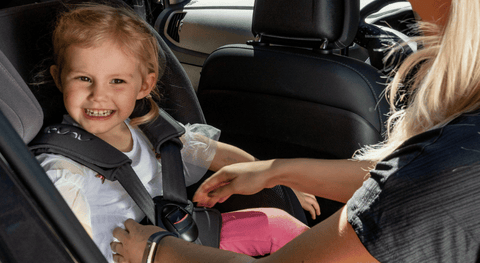When it comes to the safety of your child while traveling by car, choosing the right car seat is essential. In the UK, all car seats must meet stringent EU safety standards, but finding the “best” seat for your child can still be a challenging decision. With so many options available, from rear-facing seats to high-back boosters, how do you determine which is best for your family?
In this extended guide, we’ll help you navigate the key considerations when choosing a car seat, discuss the differences between forward-facing and rear-facing seats, and offer insights on how to keep your child safe as they grow.
What Are the Best Child Car Seats?
This is one of the most frequently asked questions, but it's difficult to provide a one-size-fits-all recommendation. The best car seat for your child depends on several factors, including their age, weight, height, and the type of car you drive.
All child car seats sold in the UK meet the required safety standards, whether they're approved under ECE R44/04 or the newer R129 (i-Size) regulations. However, some seats offer additional features that can enhance safety or make installation easier.
When choosing the best seat, consider the following factors:
- Affordability: Choose a car seat that fits your budget without compromising on safety.
- Suitability: Ensure the seat is appropriate for your child’s size, weight, and age.
- Compatibility: Check that the car seat fits securely in your vehicle.
- Vehicle Approval: Some car seats are specifically approved for certain vehicles, so check compatibility with your car model.
Forward-Facing vs. Rear-Facing Car Seats: Which Is Safer?
One of the most important decisions you’ll make is whether to use a forward-facing or rear-facing seat for your child. Research consistently shows that rear-facing seats offer significantly more protection than forward-facing seats, especially for younger children.
The Benefits of Rear-Facing Seats
In a rear-facing seat, the force of a collision is distributed more evenly across the child’s head, neck, and spine. This positioning is crucial because infants and toddlers have proportionally larger heads and weaker neck muscles than adults. In the event of a frontal crash (the most common type of collision), a rear-facing seat reduces the risk of serious injury by as much as 90%.
Because of these safety benefits, UK law now requires children to travel in a rear-facing car seat until they are at least 15 months old. However, many experts, including those at the In Car Safety Centre, recommend extending this period for as long as possible.
Extended Rear-Facing Seats
Extended Rear-Facing (ERF) seats allow children to remain rear-facing up to approximately 25kg (around 5 to 6 years old). These seats provide an additional layer of protection beyond the legal minimum requirements. In countries like Sweden, where rear-facing seats are used until children are at least 4 years old, child fatalities in car accidents are remarkably low.
In the UK, you can find extended rear-facing seats that are suitable for toddlers up to 18kg (roughly 3½ to 4 years old). Many of these models offer the option to switch between rear-facing and forward-facing, allowing you to continue using the same seat as your child grows.
When to Transition to Forward-Facing Car Seats
Forward-facing car seats become appropriate when your child has outgrown their infant carrier, typically around 13kg. While forward-facing seats are safe, they do not offer the same level of neck and spine protection as rear-facing seats. Still, they are designed to meet all safety standards when used correctly.
When using a forward-facing seat, it’s important to:
- Ensure the harness is correctly positioned and tightened to fit snugly around your child’s body.
- Use an ISOFIX system where possible, as it offers the simplest and most secure installation.
- Choose a seat that accommodates your child’s size, typically up to 18kg or 105cm in height (around 3½ to 4 years old).
High-Back Boosters: The Final Stage in Child Car Seats
Once your child weighs at least 15kg, you can legally switch to using a high-back booster seat. However, it’s often safer to wait until your child is closer to 18kg, when they can better understand the importance of sitting correctly and using the seatbelt properly.
High-back boosters are designed to position the seatbelt correctly across the child’s shoulder and provide added protection to the head and sides. These seats should be used until your child reaches 135cm in height or 12 years of age, whichever comes first. This is not just a recommendation but a legal requirement in the UK.
What About Backless Booster Seats?
Since March 2017, UK regulations have prohibited the manufacture of backless booster seats for children under 125cm in height or weighing less than 22kg. While older backless boosters can still be used for children who meet these minimum size requirements, high-back boosters are generally considered a safer option as they offer more comprehensive protection.
Common Car Seat Mistakes to Avoid
Even the best car seat can fail to protect your child if not used correctly. Here are some common mistakes to avoid:
- Using a seatbelt too soon: Children under 135cm or 12 years old should always use a car seat or booster. Switching to just a seatbelt before they meet these criteria is dangerous.
- Incorrect harness fit: Ensure the harness fits snugly around your child. Thick clothing, like winter jackets, can create slack in the harness and reduce its effectiveness.
- Poor installation: Always double-check that the car seat is correctly installed. Many modern seats come with indicators to show when they’re securely fitted.
- Unsecured items: Loose items in the car, such as toys or bags, can become dangerous projectiles in a collision. Make sure everything is safely stowed away.
Book a Car Seat Consultation
Choosing the right car seat for your child can feel overwhelming, but you don’t have to do it alone. At the In Car Safety Centre, our team of experts is here to help. We offer personalized consultations to ensure that the seat you choose is the best fit for your child and your vehicle.
Conclusion: Safety First
The best child car seat is one that is properly fitted, suitable for your child’s age and size, and easy for you to use correctly every time. Whether you opt for an extended rear-facing seat, a forward-facing seat, or a high-back booster, the key is to ensure that your child is safely secured on every journey.
For expert advice, book a consultation with one of our car seat specialists today, and don’t forget to subscribe to our mailing list for the latest updates on child safety.






Comments (0)
There are no comments for this article. Be the first one to leave a message!